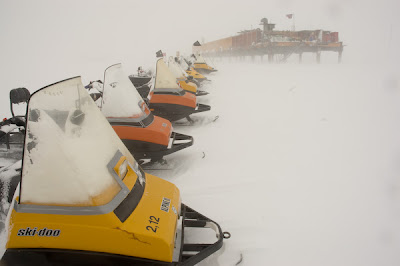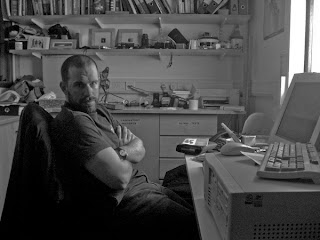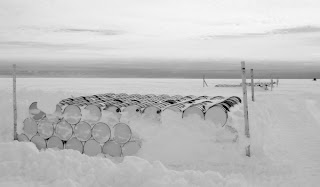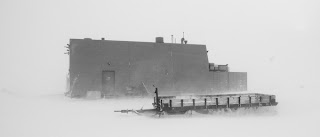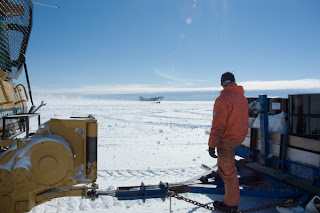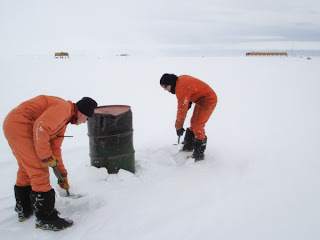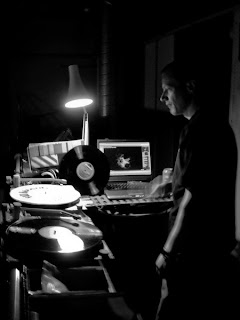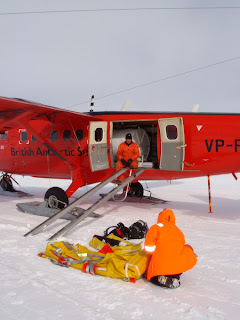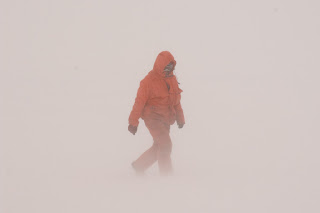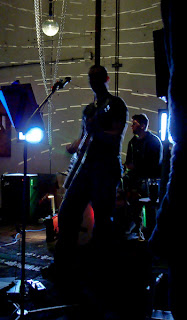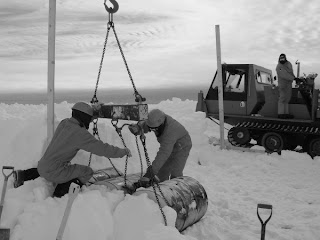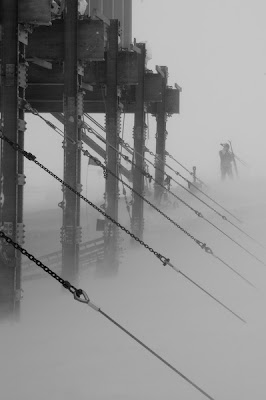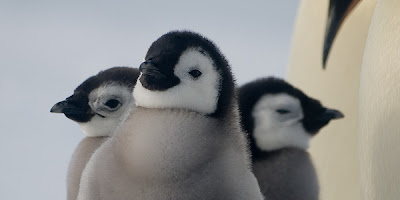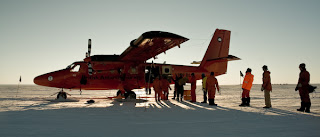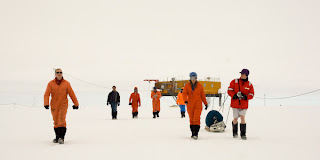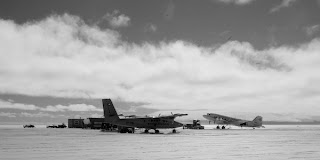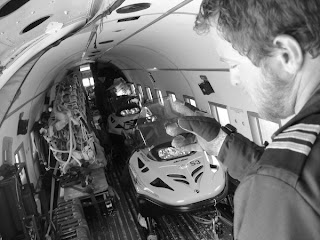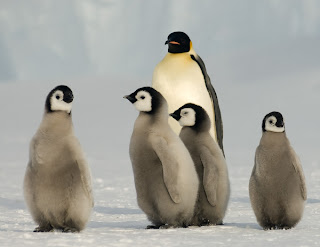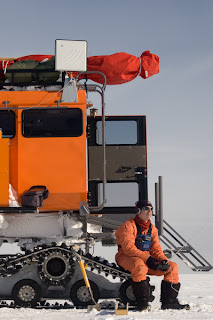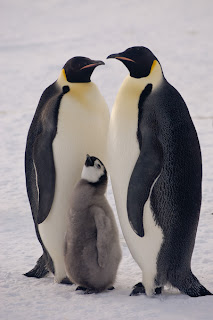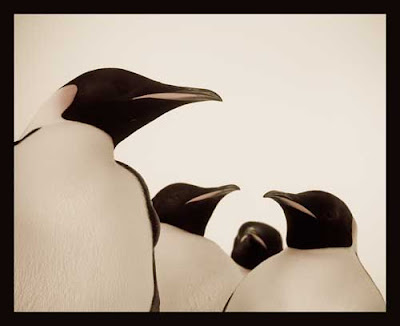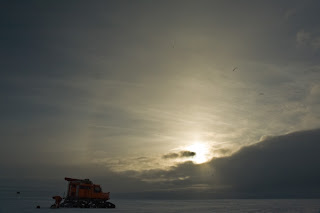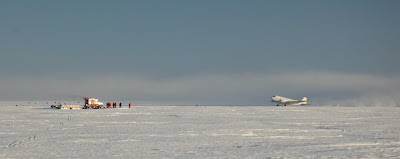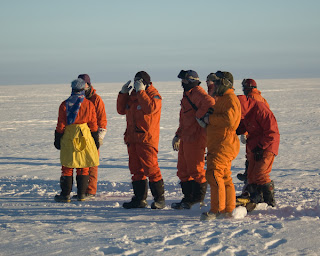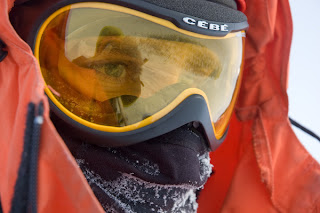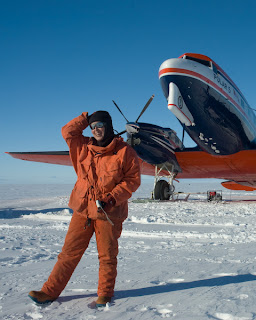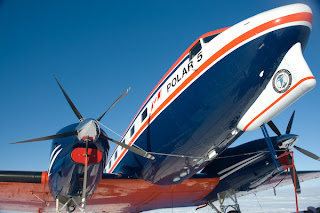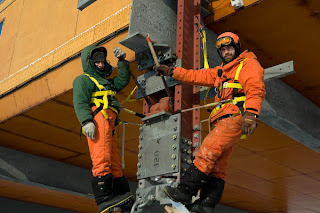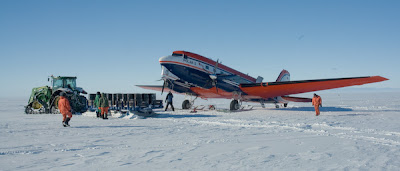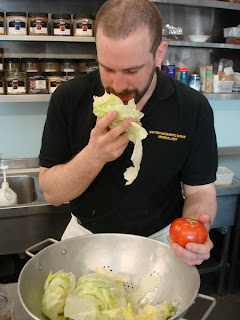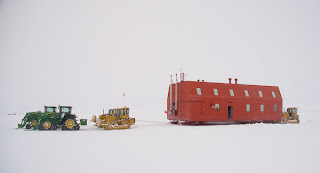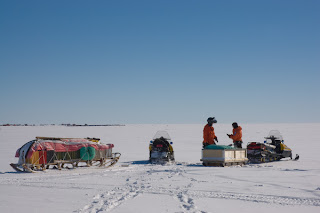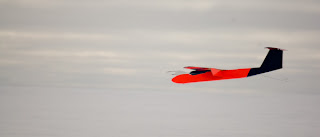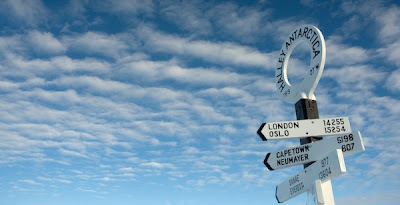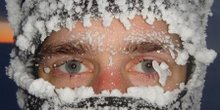A Very Busy Christmas
Up On The Continent
Putting ozone sensors in at 9000 ft

I finally did it! After almost a year in the Antarctic, I have at last stepped on the continent itself; for unlike the Arctic, the Antarctic is a continent with land underneath the ice cap. However, Halley, lying as it does on the Brunt Ice Shelf 150m thick, has water flowing beneath it and though on a good day we can see the continent gently sloping up into a plateau some 30 miles away, the closest I have been was into the hinge zone on my first winter trip, a few heavily crevassed miles short of land.
Crevasses at the Edge of the Continent
Wide enough to consume whole any vehicle (or plane...)

One of the summer science projects is the installation of a network of ozone sensors in the vicinity of the station (vicinity being a relative term as they cover an area that must be close to the size of England). Powered by their own wind turbines, a solar panel and a large battery, the sensors will record the low-level ozone levels across the year before being retrieved next year along with the data they have recorded. They form an extension to one of the projects at Halley to better understand the chemistry of ozone in the lower atmosphere, which has also seen amongst other things the blimp flights over base.
Digging the Kit In
Kirsty (Metbabe), Andy (Ozone Scientist) and Mark (Pilot) get started

Anyway, I got the opportunity to join a flight putting one of these stations in a few hundred miles from base up on the continent, for the other side of the Hinge Zone the continent rises rapidly to a relatively high plateau, noticeable when I came to lug the large battery box about a hundred metres and found myself more out of breath than I expected- they are heavy though! So after a two hour flight in the BAS Twin Otter, we found ourself near the preselected spot, a quick aerial survey suggested numerous crevasses, so Mark took us a few miles further on and then descended.
Flying Back Over the Hinge Zone
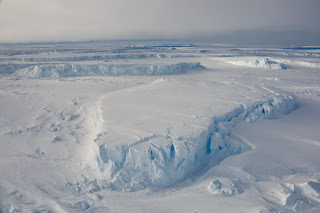
Field landings on ice always follow the same routine, a fly-over to make sure there are no crevasses, a descent and 'trail skis' (with the skis on the bottom of the aircraft running along the ground) followed by another fly-over to see if any crevasses hidden by snow bridges have opened up under the weight of the plane. All being well the plane descends for the last time; the beauty of the Tw'Otters is the limited space in which they can stop and take-off with the plane shuddering to a rapid halt.
Putting Up the Solar Panel
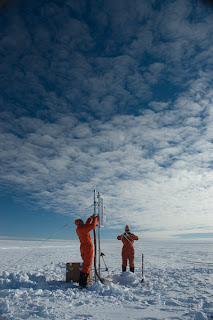
As ever, it is the space and silence that is so difficult to describe or capture photographically. Coming in by plane there are no tracks, no marker on the ground, nothing as far as the eye can see and the realisation that perhaps nobody or at least the very few have been across this area before. A brief 90 minutes of digging, a quick check to ensure the instruments are working and its back in the aircraft again for the journey home.
Co-Piloting Bravo Lima
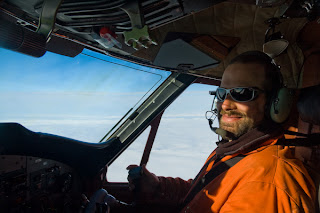
Though the Twin Otters are single pilot planes, wherever they fly in the Antarctic a co-pilot always travels with the pilot, their main skill being the ability to put up a tent, light a Primus stove and Tilley lamp should the plane be forced to spend an unscheduled night off base (all carried in the rear of the plane). So on the flight back, I had the opportunity to sit up front next to Mark in the co-pilot's seat which affords a spectacular view of the Antarctic- a special journey. All the BAS pilots are very experienced and most have experience as instructors, so there was a great chance to learn about the seemingly daunting sets of controls and gauges.
Returning Home
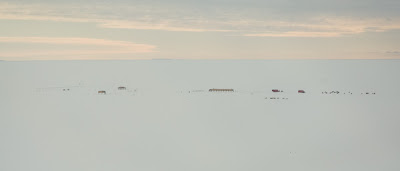
Flying back we came over some spectacular crevasse fields, particularly as the ice sheet runs down into the Hinge Zone, where the Brunt meets the continent. The monster crevasses would easily consume a vehicle or two across their width. However, the most humbling part is as ever flying back in towards base and realising how insignificant our presence is on the whole shelf, with ice extending as far as can be seen around the small black dots that have formed my home for the last year.
The Shackleton At the Creeks
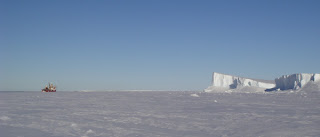
And then began relief. The Shackleton finally broke through a tough patch of ice to find a large lead that led all the way towards us and with a suitable site identified at the creeks, moored up a mere 14km from base; with the larger Anderma five days behind, the pressure was on to discharge the Shackleton to avoid having the second ship hanging around.
Heading Down to the Ship
Sitting on sleds behind a Challenger
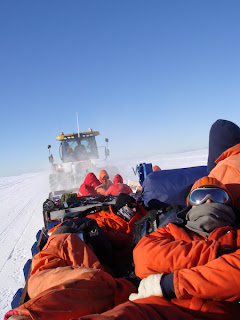
The creeks are headlands created by the turning force on the shelf as it slowly flows towards the Weddell sea while still grounded on the underwater hills that form the McDonald Ice Rumples. As the shelf slowly moves westward, the creeks gradually open up until their headlands eventually calve off. With a kilometre of sea ice between the ship and the cliffs, along with a steep ramp created in a day by a pair of bulldozers, Creek 4 provides an ideal site for relief, particularly as the large Cat Challengers can cover the distance from the base to the cliffs in about half an hour.
Returning Home
Kirk (FGA) and I get the ski-doos ready
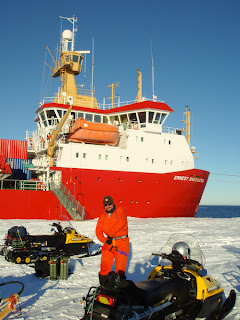
As mooring the ship up on the ice takes several hours, with the creeks so close by there was a chance on the first evening for a handful of the winterers to spend a few hours down at the ship for a change of scenery and fresh food including the best salad I have had in a long time!
Unloading Refrigerated Food
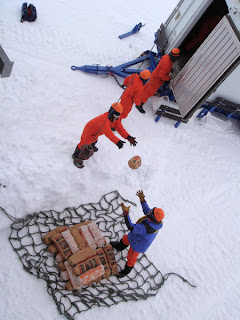
Relief means all hands to the pump, as all the supplies for the year come in and need to be stowed somewhere. With the increased number of people on station for the summer, that also means a larger Halley V relief in terms of food and drink. Already working twelve hours a day, as we will be for the whole of summer, the whole place moves up a gear, with teams on twenty-four hours a day, in two shifts.
Craning Food Onto the Platform
Jules and Deon get ready to unload the fresh food
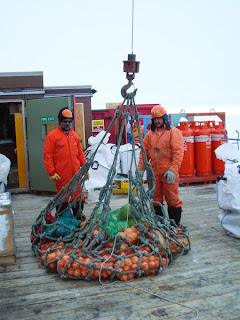
Christmas Day, meanwhile, disappeared in a blur of cargo movement, unpacking and the general mayhem of relief. However, the chefs managed to find some turkey from somewhere and as ever rustled up a fine dinner.
The Laws Corridor Lined With Food
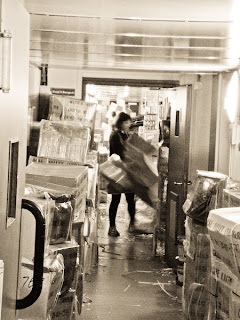
With the whole place plunged into relative chaos, space has to be found for items in the already tightly packed Laws. Unpacking the food is a particularly painful process, as each cardboard box is filled with shredded paper to cushion the contents on the journey South. However much care one takes, the paper goes everywhere before being scooped up and compacted so it can be sent back to the UK for recycling.
Solar Halo With Sundogs and Parhelic Circle
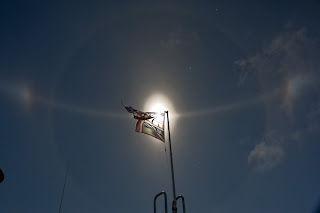
In the midst of this epic restocking session, the clouds cleared and what appeared to be diamond dust suddenly appeared, producing for no more than five minutes the optical effect I have wanted to see all winter- a full parhelic circle. That is the horizontal line in the photo above continuing to form a much larger circle over our heads than can be seen in this relatively narrow angle photo. Before I could capture the whole thing in a photograph, it had gone.
Loading Empty Drums For Shipping Out
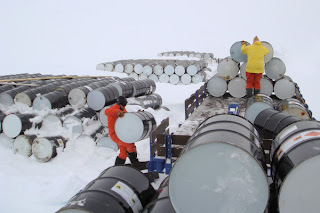
Having emptied the ship of all its cargo, including around 2000 full fuel drums and several new vehicles, it was time for the waste to head out. Along with all the waste I have spent the winter packaging up, are several hundred empty fuel drums heading back to South Africa for re-use. At nearly 50lbs each, it was another knackering full day's work loading them on to sleds to transport down to the ship, made harder by miserable weather.
The First Load Of Empties Heads Out

The bulk of the moving cargo used to be done by Sno-Cat but the Challengers brought in last year, speed the whole thing up. In essence they are large tractors with special tracks retro-fitted for the snow, which can take much heavier loads at greater speeds across the shelf. The last kilometre or so on the sea ice, though, is still carried out by older and more expendable Sno-Cats taking each sledge individually across the potentially precipitous ice.
Footprints in the Snow

To finish I have at last managed to capture one of the odder sights that are common here, that of footprints in the snow around which the less compacted ice has blown them away leaving them as 'positives' standing proud of the ice surface rather than the usual 'negative' pressed into a surface. It seems therefore appropriate to show the negative as a print, rather than a positive- confused yet?
Crevasses

This comes with best wishes to all my friends and family for this my second Christmas away from home and hopes for a Happy New Year- it will not be long before I am home again.
My Other Home

Putting ozone sensors in at 9000 ft

I finally did it! After almost a year in the Antarctic, I have at last stepped on the continent itself; for unlike the Arctic, the Antarctic is a continent with land underneath the ice cap. However, Halley, lying as it does on the Brunt Ice Shelf 150m thick, has water flowing beneath it and though on a good day we can see the continent gently sloping up into a plateau some 30 miles away, the closest I have been was into the hinge zone on my first winter trip, a few heavily crevassed miles short of land.
Crevasses at the Edge of the Continent
Wide enough to consume whole any vehicle (or plane...)

One of the summer science projects is the installation of a network of ozone sensors in the vicinity of the station (vicinity being a relative term as they cover an area that must be close to the size of England). Powered by their own wind turbines, a solar panel and a large battery, the sensors will record the low-level ozone levels across the year before being retrieved next year along with the data they have recorded. They form an extension to one of the projects at Halley to better understand the chemistry of ozone in the lower atmosphere, which has also seen amongst other things the blimp flights over base.
Digging the Kit In
Kirsty (Metbabe), Andy (Ozone Scientist) and Mark (Pilot) get started

Anyway, I got the opportunity to join a flight putting one of these stations in a few hundred miles from base up on the continent, for the other side of the Hinge Zone the continent rises rapidly to a relatively high plateau, noticeable when I came to lug the large battery box about a hundred metres and found myself more out of breath than I expected- they are heavy though! So after a two hour flight in the BAS Twin Otter, we found ourself near the preselected spot, a quick aerial survey suggested numerous crevasses, so Mark took us a few miles further on and then descended.
Flying Back Over the Hinge Zone

Field landings on ice always follow the same routine, a fly-over to make sure there are no crevasses, a descent and 'trail skis' (with the skis on the bottom of the aircraft running along the ground) followed by another fly-over to see if any crevasses hidden by snow bridges have opened up under the weight of the plane. All being well the plane descends for the last time; the beauty of the Tw'Otters is the limited space in which they can stop and take-off with the plane shuddering to a rapid halt.
Putting Up the Solar Panel

As ever, it is the space and silence that is so difficult to describe or capture photographically. Coming in by plane there are no tracks, no marker on the ground, nothing as far as the eye can see and the realisation that perhaps nobody or at least the very few have been across this area before. A brief 90 minutes of digging, a quick check to ensure the instruments are working and its back in the aircraft again for the journey home.
Co-Piloting Bravo Lima

Though the Twin Otters are single pilot planes, wherever they fly in the Antarctic a co-pilot always travels with the pilot, their main skill being the ability to put up a tent, light a Primus stove and Tilley lamp should the plane be forced to spend an unscheduled night off base (all carried in the rear of the plane). So on the flight back, I had the opportunity to sit up front next to Mark in the co-pilot's seat which affords a spectacular view of the Antarctic- a special journey. All the BAS pilots are very experienced and most have experience as instructors, so there was a great chance to learn about the seemingly daunting sets of controls and gauges.
Returning Home

Flying back we came over some spectacular crevasse fields, particularly as the ice sheet runs down into the Hinge Zone, where the Brunt meets the continent. The monster crevasses would easily consume a vehicle or two across their width. However, the most humbling part is as ever flying back in towards base and realising how insignificant our presence is on the whole shelf, with ice extending as far as can be seen around the small black dots that have formed my home for the last year.
The Shackleton At the Creeks

And then began relief. The Shackleton finally broke through a tough patch of ice to find a large lead that led all the way towards us and with a suitable site identified at the creeks, moored up a mere 14km from base; with the larger Anderma five days behind, the pressure was on to discharge the Shackleton to avoid having the second ship hanging around.
Heading Down to the Ship
Sitting on sleds behind a Challenger

The creeks are headlands created by the turning force on the shelf as it slowly flows towards the Weddell sea while still grounded on the underwater hills that form the McDonald Ice Rumples. As the shelf slowly moves westward, the creeks gradually open up until their headlands eventually calve off. With a kilometre of sea ice between the ship and the cliffs, along with a steep ramp created in a day by a pair of bulldozers, Creek 4 provides an ideal site for relief, particularly as the large Cat Challengers can cover the distance from the base to the cliffs in about half an hour.
Returning Home
Kirk (FGA) and I get the ski-doos ready

As mooring the ship up on the ice takes several hours, with the creeks so close by there was a chance on the first evening for a handful of the winterers to spend a few hours down at the ship for a change of scenery and fresh food including the best salad I have had in a long time!
Unloading Refrigerated Food

Relief means all hands to the pump, as all the supplies for the year come in and need to be stowed somewhere. With the increased number of people on station for the summer, that also means a larger Halley V relief in terms of food and drink. Already working twelve hours a day, as we will be for the whole of summer, the whole place moves up a gear, with teams on twenty-four hours a day, in two shifts.
Craning Food Onto the Platform
Jules and Deon get ready to unload the fresh food

Christmas Day, meanwhile, disappeared in a blur of cargo movement, unpacking and the general mayhem of relief. However, the chefs managed to find some turkey from somewhere and as ever rustled up a fine dinner.
The Laws Corridor Lined With Food

With the whole place plunged into relative chaos, space has to be found for items in the already tightly packed Laws. Unpacking the food is a particularly painful process, as each cardboard box is filled with shredded paper to cushion the contents on the journey South. However much care one takes, the paper goes everywhere before being scooped up and compacted so it can be sent back to the UK for recycling.
Solar Halo With Sundogs and Parhelic Circle

In the midst of this epic restocking session, the clouds cleared and what appeared to be diamond dust suddenly appeared, producing for no more than five minutes the optical effect I have wanted to see all winter- a full parhelic circle. That is the horizontal line in the photo above continuing to form a much larger circle over our heads than can be seen in this relatively narrow angle photo. Before I could capture the whole thing in a photograph, it had gone.
Loading Empty Drums For Shipping Out

Having emptied the ship of all its cargo, including around 2000 full fuel drums and several new vehicles, it was time for the waste to head out. Along with all the waste I have spent the winter packaging up, are several hundred empty fuel drums heading back to South Africa for re-use. At nearly 50lbs each, it was another knackering full day's work loading them on to sleds to transport down to the ship, made harder by miserable weather.
The First Load Of Empties Heads Out

The bulk of the moving cargo used to be done by Sno-Cat but the Challengers brought in last year, speed the whole thing up. In essence they are large tractors with special tracks retro-fitted for the snow, which can take much heavier loads at greater speeds across the shelf. The last kilometre or so on the sea ice, though, is still carried out by older and more expendable Sno-Cats taking each sledge individually across the potentially precipitous ice.
Footprints in the Snow

To finish I have at last managed to capture one of the odder sights that are common here, that of footprints in the snow around which the less compacted ice has blown them away leaving them as 'positives' standing proud of the ice surface rather than the usual 'negative' pressed into a surface. It seems therefore appropriate to show the negative as a print, rather than a positive- confused yet?
Crevasses

This comes with best wishes to all my friends and family for this my second Christmas away from home and hopes for a Happy New Year- it will not be long before I am home again.
My Other Home


